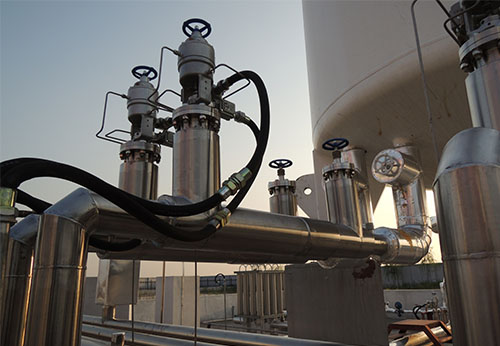Applicable media and temperature range of cryogenic valves
Posted by Bundor valve
The design and material selection of cryogenic valves must be able to withstand extreme low temperature environments to prevent material embrittlement and seal failure. The following will discuss in detail the media and temperature ranges applicable to cryogenic valves.

Applicable media
1. Liquefied natural gas (LNG): LNG is a medium formed by liquefying natural gas by cooling it to about -162°C (-259°F). During its storage and transportation, it requires the use of special cryogenic valves to ensure the sealing and safety of the system.
2. Liquefied petroleum gas (LPG): LPG is generally liquefied at -40°C to -45°C (-40°F to -49°F). Cryogenic valves ensure its stability during pressurization and storage and transportation in this medium.
3. Liquid oxygen (LOX): Liquid oxygen is a combustion aid liquefied at -183°C (-297°F). In aerospace and hospital oxygen supply systems, cryogenic valves ensure the safe transportation and use of liquid oxygen.
4. Liquid nitrogen (LIN): Liquid nitrogen is a medium formed by liquefying nitrogen at temperatures below -196°C (-320°F). It is widely used in food freezing, metal processing and scientific experiments. Cryogenic valves play a key role in fluid control in these applications.
5. Liquid hydrogen (LH2): Liquid hydrogen is usually liquefied below -253°C (-424°F) and is used in aerospace launches, energy storage and other fields. Its storage and transportation process requires extremely high low-temperature resistance of valves.
Temperature range
1. Stainless steel and nickel-based alloys: These materials can better resist low-temperature embrittlement and are often used to handle liquid nitrogen, liquid oxygen and other media. The applicable temperature is between -196°C (-320°F) and -253°C (-424°F).
2. Polymer materials such as polytetrafluoroethylene (PTFE) and polyurethane: These materials have excellent low-temperature resistance and are often used to make seals. They can be used in the temperature range of -40°C to -196°C (-40°F to -320°F).
3. Cryogenic steel: Specially designed cryogenic steel is suitable for extreme low-temperature environments such as liquefied natural gas and can withstand temperatures of -162°C (-259°F).
Through a wide range of material selection and advanced design, cryogenic valves can maintain effective working conditions in extremely cold environments, ensuring the safety and reliability of industrial processes.

Applicable media
1. Liquefied natural gas (LNG): LNG is a medium formed by liquefying natural gas by cooling it to about -162°C (-259°F). During its storage and transportation, it requires the use of special cryogenic valves to ensure the sealing and safety of the system.
2. Liquefied petroleum gas (LPG): LPG is generally liquefied at -40°C to -45°C (-40°F to -49°F). Cryogenic valves ensure its stability during pressurization and storage and transportation in this medium.
3. Liquid oxygen (LOX): Liquid oxygen is a combustion aid liquefied at -183°C (-297°F). In aerospace and hospital oxygen supply systems, cryogenic valves ensure the safe transportation and use of liquid oxygen.
4. Liquid nitrogen (LIN): Liquid nitrogen is a medium formed by liquefying nitrogen at temperatures below -196°C (-320°F). It is widely used in food freezing, metal processing and scientific experiments. Cryogenic valves play a key role in fluid control in these applications.
5. Liquid hydrogen (LH2): Liquid hydrogen is usually liquefied below -253°C (-424°F) and is used in aerospace launches, energy storage and other fields. Its storage and transportation process requires extremely high low-temperature resistance of valves.
Temperature range
1. Stainless steel and nickel-based alloys: These materials can better resist low-temperature embrittlement and are often used to handle liquid nitrogen, liquid oxygen and other media. The applicable temperature is between -196°C (-320°F) and -253°C (-424°F).
2. Polymer materials such as polytetrafluoroethylene (PTFE) and polyurethane: These materials have excellent low-temperature resistance and are often used to make seals. They can be used in the temperature range of -40°C to -196°C (-40°F to -320°F).
3. Cryogenic steel: Specially designed cryogenic steel is suitable for extreme low-temperature environments such as liquefied natural gas and can withstand temperatures of -162°C (-259°F).
Through a wide range of material selection and advanced design, cryogenic valves can maintain effective working conditions in extremely cold environments, ensuring the safety and reliability of industrial processes.
 简体中文
简体中文 Русский
Русский Español
Español Bundor - Butterfly, Gate, Check, Ball, Globe Valve Manufacturer, Supplier & Distributor
Bundor - Butterfly, Gate, Check, Ball, Globe Valve Manufacturer, Supplier & Distributor
